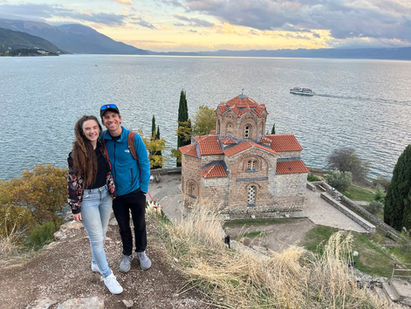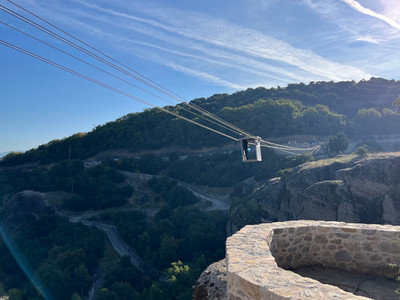



Aug 1512 min read



Our Greek adventures kept rolling as we left Mount Olympus behind, winding west through the rugged landscapes of northern Greece and making an unforgettable stop at Meteora, with its towering rock pillars and cliff-top monasteries, before setting our sights on Crete, the country’s largest island brimming with history.
The days following the Mount Olympus hike were rough on our legs. We felt like we had been trekking for a week straight, every step was a painful reminder of the climb to to Zeus' doorstep. The drive itself turned out to be a pleasant surprise. Northern Greece is filled with toll roads, highways, and endless tunnels, and honestly, worth every euro spent. After some of our road trip experiences in other Balkan countries, cruising along these smooth highways felt like a luxury. We had to laugh at ourselves because we got way too excited about the tunnels and road infrastructure. It hit us in that moment that we are officially 'older travelers'. But still, there was something impressive about them, especially knowing that the highway we were on connects all the way from Greece to Norway. Wild!
Driving through the Tempi Valley of Northern Greece was especially impressive once we learned its history. This stretch of road used to be one of the deadliest in Greece, notorious for fatal accidents on its winding mountain passes, until the government invested in a series of modern tunnels and bridges completed in 2017. Today, the new Tempi Tunnels not only make the journey smooth and safe but also form part of a highway that connects Athens all the way to northern Europe, which felt like a pretty awesome upgrade. Once we made out way further into the rolling hills, Luke was reminded of California's rolling hills and dry sun-baked landscapes.




As we descended into the valley, Meteora revealed itself in all its glory, and we were instantly blown away. For those who haven’t heard of it, Meteora is a UNESCO World Heritage Site known for its towering sandstone pillars with monasteries perched impossibly on top. These rock formations were shaped over millions of years by wind, water, and seismic activity, rising up to 550 meters (1800 feet) high.

The human history here is just as impressive as the geology. Eastern Orthodox Christian Monks began building monasteries as early as the 11th century to seek refuge from invading Ottoman Turks and local bandits. By the 16th century, 24 monasteries had been established, though only 7 remain active today, preserving centuries of spiritual and cultural tradition. The combination of these cliff-top monasteries and the jagged, monolithic rocks around them was breathtaking, and walking among them it is easy to see why Meteora has inspired religious devotion for generations.
We arrived at our charming guest house tucked beneath one of Meteora’s towering monoliths. It had a little terrace with epic views of the surrounding rocks, and we were buzzing with excitement to start exploring the area over the next couple of days.






Our first stop was the Great Meteoron Monastery, the largest and most impressive of the seven still-active monasteries in Meteora. Approaching it, we could immediately feel the scale. Perched atop a towering sandstone pillar with vertical walls, it seemed almost suspended in the sky. The monastery functions partly as a museum, open to the public on most days, but it is still an active place of worship and is closed on certain days of the week. Fun fact: the dramatic cliffs and monasteries of Meteora were used as filming locations in the James Bond film For Your Eyes Only, adding a touch of cinematic adventure.






We paid our admission fee and began the climb up a series of precarious winding stone stairs carved directly into the side of the cliff. It was tough to walk up the very steep steps to access each monastery as we were still extremely sore from our huge hike up and down Mt Olympus. Every step hurt, but the path spiraled upward, each step revealing more dramatic views, until we finally reached the top where the most incredible church awaited. Inside the corridors, churches, and chapels, there were intricate frescoes (intricate murals painted directly onto the walls), each one telling centuries-old stories of faith and devotion.








One video from 1925 completely blew us away, showing how monks were once physically hoisted up the cliffs in a net attached to a hook and pulley system. The feat seemed both terrifying and ingenious. Walking through the monastery, it was easy to imagine the lives of these monks who sought refuge from Ottoman invaders. With sheer cliffs guarding the walls, the monastery was an almost impenetrable fortress and a safe haven for worship.
Meteora is one of the most popular destinations on the Greek mainland outside of the islands. Its central location makes it accessible for long day trips from the two biggest cities, and we even saw busloads of visitors arriving from Athens and Thessaloniki. Visiting during the shoulder season was a real treat though, as we were able to enjoy the monasteries and dramatic landscapes without the usual unbearable crowds.
The next day we set out for a hike in the valley between the cliffs. At first, we thought it would be a short and easy walk, but our legs, still sore from the Mt Olympus climb, quickly reminded us otherwise. The path wound between the towering sandstone pillars, offering unique perspectives of the rocks and monasteries from below.






Later in the day, we visited three more monasteries, each with its own distinct charm and breathtaking views. The frescoes and architecture were different at every site. One of them even had a little cable cart that some of the monks travelled across the valley on to get to and from the the road.








We concluded our Meteora adventure perched atop a rocky outcrop, watching the sun sink behind the monasteries. The colors of the sky shifted from warm oranges to deep purples, and the silhouettes of the cliff-top buildings created a scene we will never forget. Meteora is a place that captures the imagination and leaves an imprint on the soul.






Meteora was magical, but it was time to continue our journey west. We paused for lunch in the charming town of Metsovo, perched on the edge of a cliff with a deep valley stretching below. This mountainous village is famous for its goat and sheep cheeses, and we couldn’t resist sampling and stocking up on the local artisan treats before continuing our drive through the regional hub of Ioannina and onward to the remote Zagori Villages nestled in the North Pindos National Park.






Our first stop in the region was the visitor center, which proved to be incredibly informative. The local guide spoke with a tone tinged with sadness as she explained how many of these villages are slowly disappearing. Their isolation, combined with the lure of city careers, continues to draw away the remaining population, leaving the historic villages sparsely inhabited and slowly fading into the mountainside. She herself had left the village she grew up in as a child with her grandparents. This part of Greece felt completely different from anything we had seen before. It was a hidden gem, far off the usual tourist trail, and we were eager to explore, though we only had two and a half days to take it all in. After our gruelling hike up Mt Olympus, our legs were still sore (a theme in this post!), so we were grateful that most of the hotspots were easily accessible by car.






The major natural attraction in the region is the Vikos Gorge, which boldly claims the title of "the deepest canyon in the world". Luke, ever the skeptical American, did a little fact-checking and discovered that the claim is based on a technical measurement of narrow distance and depth. Regardless of comparisons to the Grand Canyon, the views were absolutely unreal, and we were fortunate to witness the gorge from both ends during our visit.








Another defining feature of the North Pindos National Park is the 50 or so Zagori "stone" Villages scattered across the vast mountains, connected by a unique collection of centuries-old stone bridges. In winter, these villages are cut off from the wider world by deep snow, and waking up to our first frost of the trip, we could understand why. The autumn colours were only days away from their peak, and driving through the crisp, blue-sky landscape felt a lot like being in New Zealand. Some of the stone bridges in the Zagori region of North Pindos National Park are several hundred years old. The oldest surviving ones were built in the 16th century (so roughly 400–500 years old). They were essential for connecting the isolated villages across deep gorges and rivers, and many are still standing strong today thanks to their remarkable craftsmanship.
















We stopped at another visitor’s center in the town of Mikro Papingo and met an equally passionate guide, thrilled to have tourists to talk to. He explained that this region is one of the most abandoned parts of Greece, and that two hundred years ago, the Zagori villages were home to more people than the regional city of Ioannina. We enjoyed one final viewpoint of the Vikos Gorge before descending the steep path to the base for a completely different perspective. It was the perfect way to conclude our time in the area.














With our hearts full and cameras packed, we set our alarms early for a very early start the next day. Forty tunnels later, we made it back to Thessaloniki to return the car, catch one last sunset, and prepare for the next adventure in another spectacular corner of this incredibly diverse country: Crete.
Until Then,

- A Kiwi and A Cali











Comments